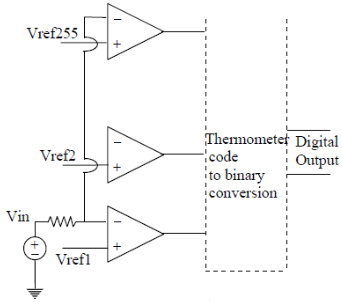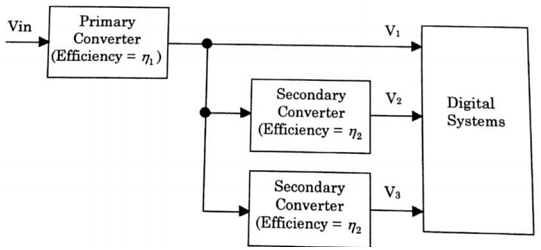Data Converters: PYQ | Digital Circuits - Electronics and Communication Engineering (ECE) PDF Download
Q.1. In an N bit flash ADC, the analog voltage is fed simultaneously to 2N— 1 comparator. The output of the comparators is then encoded to a binary format using digital circuits. Assume that the analog voltage source Vin (whose output is being converted to digital format) has a source resistance of 75 ohms as shown in the circuit diagram below and the input capacitance of each comparator is 8 pF. The input must settle to an accuracy of 1/2 LSB even for a full-scale input change for proper conversion. Assume that the time taken by the thermometer to the binary encoder is negligible. If the flash ADC has 8 bit resolution, which one of the following alternatives is closest to the maximum sampling rate?
If the flash ADC has 8 bit resolution, which one of the following alternatives is closest to the maximum sampling rate?
(a) 1 mega samples per second
(b) 6 mega samples per second
(c) 64 mega samples per second
(d) 256 mega samples per second
Correct Answer is option (b)
Q.2. An 8-bit D/A converter has step size of 20 mV. The full-scale output and the resolution will be nearly
(a) 5.1 V and 0.3%
(b) 4.6 V and 0.4%
(c) 5.1 V and 0.4%
(d) 4.6 V and 0.3%
Correct Answer is option (c)
Full scale output
Resolution = step size = 20 mV
VFS = (28–1) × resolution
= 255 × 20 mV
∴ VFS = 5.1V
Resolution
% resolution =
∴ % resolution = 0.4%
Q.3. A High speed digital Subsystem requires three voltages V1, V2 and V3 with 1 : 2 : 1 power ratings respectively. The power supply is designed with the distribute power conversion scheme as shown in the following figure. What is the overall power conversion efficiency?
 (a)
(a) 
(b) 
(c) 
(d) 
Correct Answer is option (a)
The Correct Answer Among All the Options is A
We have to determine overall power conversion efficiency. Now, efficiency(ո) is generally given as: Vout/Vin
From the diagram it is clear that Vout = V1 + 2V2 + V3(1 + 2 +1 = 4V)
Now, we have to find out Vin. Since ո= Vout/Vin, so Vin= Vout/ո
Vout=4 V, and Vout = V1 + 2V2 + V3
=> V1(X) + V2(Y) + V3(Z)
So, Vin= X + (Y/ո2) + (Z/ո3)/ ո1
Replacing X by V, we get:
Vin = V(ո2ո3 + 2ո3 + ո2)/ո2ո3ո1........ (a)
So, now substituting Vout=4 and Vin from (a), we will get option (a).
Q.4. Consider a four bit D to A converter. The analog value corresponding to digital signals of values 0000 and 0001 are 0 V and 0.0625 V respectively. The analog value (in Volts) corresponding to the digital signal 1111 is ________. [Fill in the Blank Type Question]
n = number of bit = 4
Analog Output = (Decimal equivalent of input) x (Resolution)
0000 → 0 V
0000 → 0.0625 V = Resolution of equivalent input = 1
1111 → ?
Analog Output = [Resolution] x [Decimal equivalent of Binary]
Analog Output = 0.0625 x 15
= 0.9375
Q.5. The output voltage from a 5-bit ladder type DAC that has a digital input of 11010, and by assuming 0 = 0 V and 1 = + 10V, is nearly
(a) 26.0 V
(b) 16.3 V
(c) 10.3 V
(d) 8.1 V
Correct Answer is option (d)
(11010)2 = (26)10
VDAC = resolution x (decimal equivalents)
∴ VDAC = 8.1 V
Q.6. Convert the binary number 11000110 to Gray code
(a) 001000101
(b) 10100100
(c) 11100110
(d) 10100101
Correct Answer is option (d)
Gray code = 10100101
Gray to Binary Code Converter
From the above operation, finally we can get the binary values like
b3 = g3,
b2 = b3 XOR g2,
b1= b2 XOR g1,
b0 = b1 XOR g0.
|
6 videos|76 docs|52 tests
|

|
Explore Courses for Electronics and Communication Engineering (ECE) exam
|

|






















